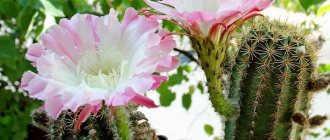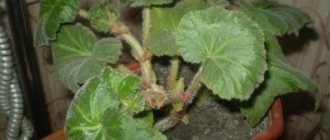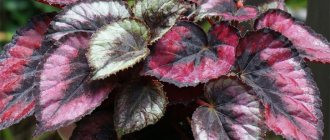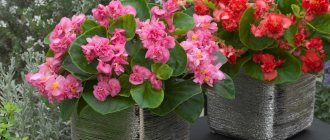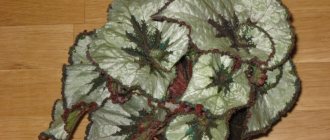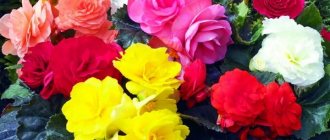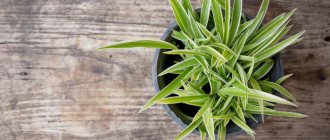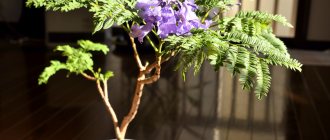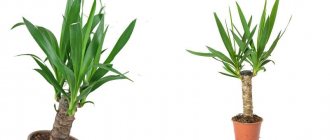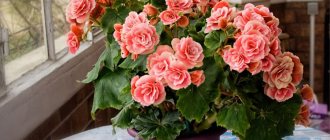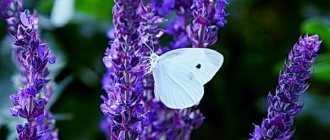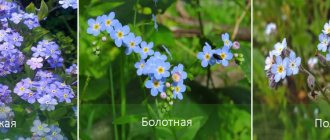Description of royal begonia
The root system is represented by a powerful creeping rhizome.
The stem is fleshy, small in size, strewn with reddish bristles.
The leaves are large, asymmetrical, pointed, have oblong petioles and a serrated edge. The leaf blades have bright and varied colors and have green, scarlet, crimson, lilac, purple and even silver inclusions. The veins on the leaves may appear a different color.
- It is interesting that the special decorativeness of this plant is caused by certain physical needs:
- The bright color and roughness of the leaves increase the surface temperature of the leaf blades, helping them evaporate more moisture. This process helps the roots receive nutrients and, therefore, intensive development of the rhizome.
- The asymmetry of the leaves allows the plant to evenly receive enough sunlight. Different leaf shapes allow them not to block each other's flow of sunlight. The flowers are pink and inconspicuous with a diameter of up to 1 centimeter. Against the background of bright leaves they have no decorative value. The seeds ripen into small fruits.
Popular varieties
Flower growers have long had favorites among varieties. These varieties are particularly decorative and are perfectly adapted to life in a city apartment.
| Species name | Character traits |
| Begonia Bauer | A tuberous variety that must be removed from the ground for the winter. A low, up to 25 cm, plant with an erect stem and large asymmetrical leaves. Flowers come in all shades from red to white. |
| Begonia naked | Long creeping trunks with rooting at nodes. The foliage is medium-sized, ovoid in shape. The inflorescences are small, racemose. Popular with winter garden owners. |
| Begonia Arthur Mallet | A drooping long stem with light green rounded leaves with contrasting burgundy or crimson spots at the petiole. A common hybrid variety. |
| Begonia rich | A perennial plant with a short thick stem. Large egg-shaped leaves combine shades from light olive to silver. The flowers are small, creamy white. |
It is better to choose varieties in accordance with the interior design and individual aesthetic preferences. Photos will help you navigate all the diversity.
Home care for Royal Begonia
Begonia does not require special conditions, but to maintain its bright colors, it is necessary to create certain conditions.
Landing
The first planting of the plant after successful cultivation from seed occurs in the fourth week. When planting, you should follow the recommendations for the composition of the soil and the type of pot.
Priming
For rex begonia, nutritious soils with medium acidity are preferred. In specialized stores you can buy ready-made soil for begonias. To prepare the soil yourself, you will need to mix the following components: peat - 1 part, sand - part, leaf soil - 2 parts, humus - 2 parts.
Choosing a pot
There are some requirements for the container for planting royal begonia. The pot must be wide for the characteristic development of the root system, contain drainage holes and a tray. The height of the pot is not critical, since the roots do not go very deep.
Watering
Watering should be done moderately and regularly. The earthen ball should not be overdried; the soil needs to be slightly moistened. But excess moisture contributes to the deterioration of fleshy stems and roots, so stagnation of water in the pot should not be allowed. When watering, it is recommended to avoid getting moisture on the leaves, which can lead to rotting of the leaves. Watering is carried out with filtered or settled water at room temperature.
Light mode
Royal begonia requires good lighting with indirect sunlight. Direct sunlight is undesirable for leaves. Window sills oriented to the east or west are suitable.
Trimming
At the beginning of the flowering period, it is recommended to trim the flower stalks, as they lead to depletion of the plant and deterioration in the appearance of the leaves.
At the end of winter - beginning of spring, a period of active growth approaches, which should be prepared by pinching the rhizome and reorienting the young parts of the root towards the center of the pot. Thanks to the actions taken, the growth of new shoots on the thinned rhizome and the formation of lush bushiness are resumed.
It is advisable to cut an old plant to restore its attractive appearance.
Thermal mode
The optimal temperature for the good development of royal begonia ranges from 17 to 25 degrees Celsius.
In summer, begonia reacts poorly to heat, and in winter it does not tolerate air overheated by heating devices.
Begonia grows well all year round, slightly slowing down its development during the onset of cold weather. In this regard, creating a rest period with a reduced temperature is not required.
Rules of care
Keeping begonia will not be difficult if you adhere to simple conditions:
- Choose a low pot, but with a diameter of 20 cm, because the rhizome grows in breadth and not in depth.
- Location. The plant loves light, but it should be moderate and diffused. Ideally, place it on the east or west side so that there is no direct sunlight. This way the foliage will retain its brightness and will not get burned. There is no need to change the position of the pot.
- Temperature. For comfortable growth and development - 16-22 degrees. Sudden changes, heat and drafts are unacceptable. You will feel good in the fresh air.
- Humidity. Optimal - 50-60%. It is not recommended to spray leaves. Place wet pebbles, sphagnum moss or a cloth dampened with water on the tray. Another option is to place a container of water nearby.
- How to water a flower. It is advisable to take water not from the tap, but settled and boiled. Irrigation 2-4 times a week. In summer, abundantly so that the soil does not dry out.
- Monthly feeding. In spring - nitrogen-containing, in summer and autumn - phosphorus-potassium. Water before application. To prevent diseases, you can use herbal infusions.
- Wipe the leaves every 2-3 weeks, as dust accumulates on them.
Reproduction
To propagate royal begonia, leaf cuttings, rhizomes and seeds are used.
For leaf propagation, the cutting is divided into several parts of equal length. Pieces of cuttings are placed in moist peat soil. The sprouts are planted at an oblique angle for successful rooting.
It is possible to grow Rex begonia from seeds. But it should be borne in mind that this method does not always bring good results, since seed germination has a low percentage.
The first sprouts have only green leaves, since the royal begonia acquires brighter colors as it matures.
How to propagate from leaf cuttings
With the powerful vegetation that royal begonia has, propagation can even be done by leaf cuttings. You can combine two planting methods and root the cutting and leaf blade separately. In this case, the leaf may take longer to root than the cutting.
Leaf cuttings can be planted either separately from the leaf or together with it or with part of it. You can root the cuttings either in water or by planting it in a substrate. When planting in the soil, the cutting that is immersed in the ground no more than 1 cm is best accepted.
Attention! When propagating begonias by leaf cuttings, the cut of the cutting must be slightly dried before rooting.
If the cutting is too long and does not stay in the cup, then it needs to be trimmed as much as possible or planted a little deeper.
Fertilizer and feeding
In the warm season, the flower needs constant feeding using mineral complex fertilizer. Feeding should be done 3 times a month, stimulating active growth.
Organic fertilizers are very useful for begonias. Manure fermented for two weeks, which is applied in liquid form when diluted with water, is suitable.
During spring, fertilizer should consist of nitrogen, potassium and phosphorus in a ratio of 1:1:1 , and by the beginning of cold weather, the content of potassium and nitrogen is reduced by 2 times.
Varieties and types of beautiful flowering begonias
When it comes to the species and varietal diversity of beautifully flowering begonias, you should prepare for uncertainty and confusion. The thing is that all modern begonias with beautiful flowering are hybrids. And even if we are talking about a specific variety, it is still represented on sale by varieties that have undergone a long and complex selection.
When choosing beautifully flowering begonias, it is not necessary to strictly follow the botanical name of the plants, because often the same varieties are named differently in different catalogs. The main thing is the decorativeness of the plant. Begonias are chosen with the heart and eyes, according to your taste and to suit your interior.
The possibilities for choosing flowering begonias are not limited by any parameter. Only in terms of the color palette, they range from the brightest to the lightest and most unusual variations of white, yellow, pink, orange, red, purple colors, not to mention a variety of watercolor and contrasting two-color combinations, further expanding the color palette of beautifully flowering begonias.
Begonia cucullata
The most popular varieties of beautifully flowering begonias
Varieties of ever-flowering or ever-flowering begonia (today given the specific name Begonia cucullata, but until now it is better known as Begonia semperflorens) are a hybrid species of begonia, which were obtained by crossing more than 5 different Latin American varieties of begonias. These are subshrubs with simple ovate, dark red or green, glossy leaves located alternately on succulent shoots. Each plant displays loose inflorescences of white, pink or red flowers appearing on long stalks from the axils of the leaves.
Flowers can be double or simple. The ever-blooming begonia blooms constantly and tirelessly. The visible differences make it easy to distinguish plants with male four-petaled flowers from those with female five-petaled flowers. This begonia has a huge number of varieties and series of varieties - from small-growing (up to 20 cm) 'Cocktail', 'Eureka', 'Olimpia', 'Queen' to medium-growing (about 25 cm) 'Ambassador', 'Vision', 'Victory' ' up to half-meter-long begonias of the 'Stara', 'Lotto', 'Baby Wing Pink', 'Inferno' series.
Hybrids of the 'Elatior' group (they are mistakenly associated with high begonia, a species plant that most often continues to be distributed under the botanical name Begonia elatior, although according to recent data it has been reclassified as the species Begonia reniformis; here it is more appropriate to talk about a separate group of varieties, rather than hybrids of the same plant - Begonia x hybrida 'Elatior').
Due to their popularity, the varieties are due to their larger flowers, reminiscent of anemones and roses, an abundance of colors and the ability to bloom in winter or almost tirelessly (in some catalogs they are even advertised as blooming all year round, although they still need a dormant period). "Elatior" is grown both indoors and in garden culture. The plants form lush compact bushes with bright flowers that densely cover the entire bush.
Begonias of the 'Lorraine' group are winter-flowering varieties of begonias that are one of the most striking decorations of the winter interior. The color palette of these begonias is limited only to white and pink shades, but the bushes resemble blooming clouds.
Begonias of the group 'Belleconia', 'Pendula' and other ampelous begonias are ampelous plants with luxurious watercolor double flowers that appear to be drooping roses. Clusters of drooping flowers are combined with an interesting pattern of drooping shoots.
Both bush and hanging varieties of tuberous begonias (Begonia x tuberhybrida) can be grown as a beautifully flowering plant indoors. These plants, familiar mainly from potted and container garden culture, are capable of blooming in open soil.
Tuberous begonias thrive in the same conditions as traditional indoor flowering begonias. After flowering, the above-ground part dies off completely, and the tubers are kept in almost dry, cool conditions (12-15 degrees) for about three months, after which they are replanted and returned to the usual environment to stimulate flowering, carefully resuming watering and fertilizing.
Begonia beautifully flowering cascade
Transfer
Royal begonia should be replanted in the spring , since during this period it is more resistant to root fractures and can quickly recover.
The pot for transplanting is chosen with a wider diameter than the previous one. The container should not be deep, since the root of the plant grows closer to the surface of the soil and does not go deep.
During the replanting process, the rhizome can be carefully freed from the old substrate.
Do not bury the neck of the rhizome, otherwise the plant will rot.
Begonia Dollar Down
It is distinguished by a pink pattern on the leaves with a black border. The leaves have a fan shape, decreasing from the edge to the middle. Plant height is 25-30 cm, color saturation depends on lighting. The plant needs at least 12 hours of daylight, loves medium-moist soil and does not tolerate drafts. If not properly cared for, it can become affected by mealybugs or leaf rust.
Diseases and measures to prevent them
Royal begonia diseases develop as a result of violation of care conditions.
- Diseases and causes of their occurrence:
- Root rot caused by excess moisture in the soil;
- Thinning leaves due to insufficient lighting;
- Brown spots due to sunburn;
- Powdery mildew on leaf blades due to high air humidity;
- Drying of the leaf edge caused by lack of moisture.
All these illnesses happen due to the fault of the grower. Therefore, it is not difficult to eliminate them by resuming proper care of begonias.
Begonia Dark Mamba
Initially, this species was called Black Mamba, which is translated from English as Black Mamba, but due to racial disputes, in order not to offend the black community, the variety was renamed Dark Mamba - Dark Mamba. The plant is distinguished by dark olive leaves with a burgundy back and a light star in the middle. The leaves are fan-shaped, increasing in size from the middle to the edge. The average height of the bush is 30 cm. It is very popular due to its unique appearance. The leaf blade has slight pubescence. To ensure that the color of the leaves is saturated, it is grown in a bright place with average humidity.
Pests and methods of controlling them
Begonia can be affected by scale insects, thrips and spider mites.
For prevention, you need to regularly inspect the leaves for pests.
In advanced cases, treatment with special medications will be required.
Royal begonia will fit perfectly into any interior. Thanks to the colorful color of the leaves, it will become a rich living decoration in the house.
The rich variety of begonias makes you think about which variety to choose. On our website there is a lot of information about decorative deciduous begonias and their care, as well as about Red-leaved, Hogweed, Spotted, Collared and Bauer and Mason begonias and about the Cleopatra variety.
Mr. Summer Resident Recommends: Rex Begonia – Doctor for Asthmatics
Thanks to its large, fleshy leaves, Rex perfectly purifies the air. It releases a lot of oxygen and active phytoncides. It was possible to find out that in the room where some varieties are grown, the concentration of Staphylococcus aureus decreases.
It is useful for people with bronchial asthma to have such a flower at home. It has antimicrobial properties, reduces the risk of allergies, and improves immunity.
Humidified air, so necessary for plant health, prevents the appearance of flying dust particles in the air and makes breathing easier.
According to the sign, begonia helps people of creative professions and contributes to a favorable atmosphere at home.
Photo
Below you can see photos of caring for the Royal Begonia Rex at home:
Botanical description, history of origin, how does it bloom?
Perennial subshrub with hanging shoots. The asymmetrical leaves can reach 120 mm, have an elegant but slightly oblong shape, and have a smooth surface. On one side the plant is red, and on the other it is greenish with dark shades along the edges of the leaves. Coral-red flowers with a diameter of 1.5 cm are arranged only in groups, usually collected in a racemose inflorescence.
The flowers of the plant are unisexual. Blooms in summer. Around 1956, at an orchid auction in London, a new type of flower appeared - the Royal Begonia. A little later, breeders developed dozens more different varieties. Since then, the plant has evolved into many hybrid species. The plant was crossed with Asian species. This is why the royal begonia remained the ancestor of all common varieties.
